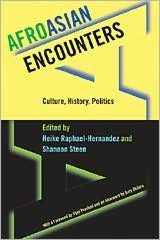

 |

|

The average rating for AfroAsian Encounters: Culture, History, Politics based on 2 reviews is 4 stars.
Review # 1 was written on 2019-12-13 00:00:00 Lori A Dupras Lori A DuprasThe point of this book seems in part to critique contemporary integrationist representations of American culture (from 80s buddy films to white feminists calling other white feminists out as racists) as built from problematic racial and gender formulations of difference as cast visibly in the body. It is an attempt to answer the question of how racism and sexism remain mutually constitutive in a post-civil rights embrace of multi-culturalism. Weigman examines race and gender through regimes of the visual, using an analysis of the power of the visible drawn from Foucault. To some extent, her book examines how the formulation "blacks and women" function. The first two chapters look at the transformation from natural science to the biological sciences (drawing heavily on Foucault) to understand the way citizenship becomes linked to certain types of visibly produced anatomies. How is the modern subject visibility and invisibility produced? The third chapter looks at narratives of lynching. Her argument (summarized way too simply) is that if citizenship is gendered male, gendering black males as female through castration prevented them from achieving male citizenship. The black arts movement and black power movement responds by depicting white men as homosexuals to reassert black men as more masculine than white men. If difference is produced visibly in the bodies the body becomes central to the policing of racial and gendered citizenship. Her readings of Richard Wright and Ralph Ellison are strong. Her fourth chapter analyzes interracial buddy flicks from the 1980s (you know, like Lethal Weapon ). The argument is roughly that these films reconfigure white masculinity in relationship to black masculinity in a way that reaffirms the centrality of white masculinity and the role of the white man as hero. She examines this cultural logic in the context of the post-civil rights movement. In the fifth chapter she looks at debates about the American canon, particularly offering a re-reading of the racialized logic of Fielder's Love and Death in the American Novel and the way in which Fielder both eroticizes and simultaneously de-eroticizes the relationships between white and black men he sees at the heart of American literary identity. Think Huck Finn and Jim: "The mutual love of a white man and a colored" and "a white and a colored American male flee from civilization into each other's arms." As I have yet to read Fielder (despite checking Love & Death out from the library two years ago in a bout of shame about my ignorance of this classic), I can't evaluate her argument beyond the reinvigorated inspiration to finally read Fielder. The final chapter examines the crisis of feminism caught between the critique of the historically white female subject of feminism and the "postmodern suspicion" on the very existence of the subject at all. The problem articulated is in part that the physical exteriority of the subject is perceived as determinant of the interiority of subjectivity. [Note: I would assign this essay in a class on feminist theory] I felt like the most clearly written parts of the book were the parts that engaged close readings of films and texts. They were artfully done. Her book will be useful for me both in examining the meaning of citizenship in my introduction but also in thinking about the racialized meanings of sex and the body in relationship to US empire in Bulosan's and Galarza's work. |
Review # 2 was written on 2011-05-14 00:00:00 Michael Karner Michael KarnerKevorkian presents a brisk exploration of racialized images of technology in American popular culture. Making short work of the "pasty white computer nerd" stereotype by referencing movies and advertising, he submits that the blackness of pop-technology contributes to racist images of black utility-- that people of color, like the machines they use, are reduced to accessory and rote functionality. While this strikes me as too simplistic at points, the case studies he compiles, including "The Hunt for Red October", the "Die Hard" franchise, and "The Matrix" trilogy, are effectively ordered so as to compose a broad overview of American pop culture, which definitely gives added weight to his thesis. The book is stuffy, clogged with academic jargon, techno-jargon, and sociology jargon, but it ultimately does what it's supposed to do: it makes you think harder about ambient popular culture, look behind the medium to analyze the message, and understand why people act the way they do. |
CAN'T FIND WHAT YOU'RE LOOKING FOR? CLICK HERE!!!